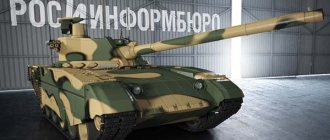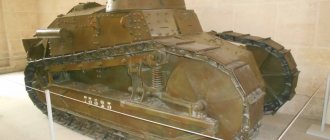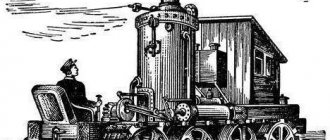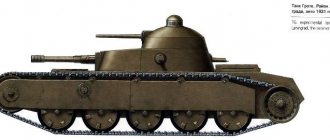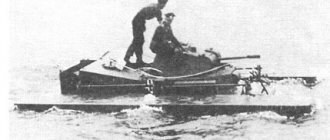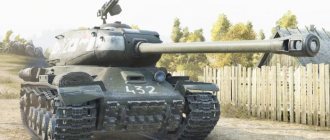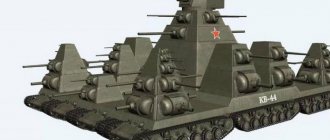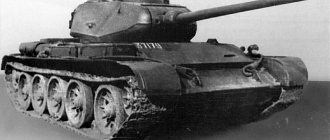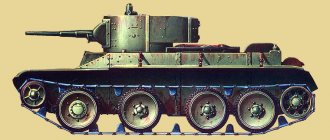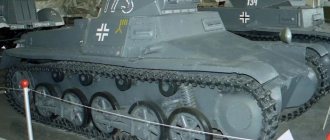Leichttraktor4 su5basata su11 utenti.
Like
The Leichttraktor is a basic but quite effective type of armored vehicle. This type of tank is designed for close combat with higher-level tanks with the aim of finishing off after a preliminary attack, as well as for direct confrontation with same-level enemies with the goal of complete destruction.
The Leichttraktor tank is used in the game as a starting arsenal, the research and upgrade of which further contributes to the opening of other branches of German armored vehicles, namely: PzKpfw 35(t), PzKpfw II, Panzerjager I and Sturmpanzer I “Bison” tanks.
Leichttraktor tank in the game
Research and upgrade of the Leichttraktor tank are based on the basic principles of the game - this is a kind of initial stage intended to introduce the player to the course of affairs, includes elements of training and familiarization with German armored vehicles. Having carefully studied the principles of research and upgrade of this tank, it will be easier for the player in the future to navigate both armored vehicles and the processes of combat.
The Leichttraktor tank is the initial element of German armored vehicles. This type of tank belongs to light armored vehicles. The Leichttraktor tank is received free of charge by every player who just starts the game. Researching and upgrading this tank is not a complicated process, and the player will bring the armored vehicle to the top configuration in a fairly short gaming period. So, what modules are needed for the Leichttraktor tank and what is the plan for upgrading it:
- First of all, you need to pay attention to the engines and chassis. The development of these modules will give maneuverability to your armored vehicles, making the tank more agile and easy to control.
- Take care of the 2cm Breda gun - this combat weapon is the best option for the Leichttraktor tank. With the help of this weapon you will ideally conduct battles with such single-level armored vehicles as the MC-1 and T1 Cunningham.
- No tank can do without a walkie-talkie: ensure communication is available and you will always be aware of your team’s actions.
- You also need to choose a second weapon - choose from the list presented the one that matches your ideas about efficiency.
Combat efficiency is an important component in the gameplay. Each tank has its own principles of combat, strategic and tactical features. Do not forget that the Leichttrakt tank is the initial version of armored vehicles and, accordingly, the combat effectiveness of this tank is based on the basic principles of combat.
What tactics should you follow when using the Leichttraktor tank in battle? The main task of this tank is to support stronger armored vehicles, as well as to conduct diversionary maneuvers. You can also use Leichttraktor in close combat, provided that you need to finish off the enemy. Most often, the Leichttraktor fires from cover. But it is also necessary to take into account the fact that the tank’s turret is located in the rear part of the hull, so for an accurate shot, your tank will need to move almost full hull out of cover. We must not forget that the engine is located in the front of the armored vehicle. Accordingly, if you recklessly expose yourself to enemy fire, there is a risk of engine damage and even a tank fire.
The choice of the number of shells and filling the ammunition stowage can be a decisive factor when fighting with the Leichttraktor tank.
What equipment, equipment and ammunition does this tank use? If it is necessary to use a 20 mm gun, then a charge of 200-300 rounds of ammunition is selected. It is absolutely pointless to completely fill the ammunition stowage. If you decide to use a 37 mm cannon in battle, 25 armor-piercing shells will be enough for it to work effectively; you can also use about 15 high-explosive fragmentation shells. It is not recommended to purchase additional types of equipment and shells for the Leichttraktor tank - this tank does not have the power that should be developed for money. It is better to spend the available funds on purchasing a new tank.
Construction[edit]
Hull and armor[edit]
The appearance of the Leichttraktor, formed in the summer of 1928, was partly reminiscent of the LK II at a new technical level. True, now the chassis was a single whole, and not a frame on which the body was placed. This made it possible to significantly reduce the height of the hull, since now the floor of the fighting compartment was significantly lower, corresponding to the level of the chassis floor. There was, however, a small problem. As on the LK II, the engine was in front and the transmission was in the rear, but now the driver was located much lower. Therefore, forward visibility was worse. The Leichttraktor Rheinmetall was made in such a way that it had a forward slope, so visibility, compared to the Kp.L.Tr., was a little better. But nothing more. This was a significant drawback of this arrangement. In addition, on the Leichttraktor the tanks were located inside the engine compartment, which was not the best idea.
The tank's layout remained that of a tractor, which provided some advantages.
According to the specifications, the tank had armor protection 14 mm thick, which protected against rifle-caliber bullets from all distances. In the middle part there was a management department. The control compartment housed the driver (on the left side) and the radio operator. Since the tank's layout made it impossible to provide optimal visibility, a small turret with viewing slots was installed above the driver's head. In the stowed position, the observation turret tilted to the side. A handrail antenna was placed on the body, and the radio station was mounted on the engine bulkhead. In the aft part there was a fairly large hatch-door, allowing you to climb inside quite calmly. It must be said that Rheinmetall clearly did a better job than its competitors from Krupp in terms of developing the chassis and turret. The overall height of the chassis was 1,470 mm, which is quite a good figure for such a machine. The hatches were located more successfully, and the armor of the engine compartment was worked out much more competently.
Initial tower design.
A significant difference from the LK II was the new concept of the fighting compartment, which later became the hallmark of German tanks. The hull itself was welded (the Germans were perhaps the first to use welding on such a large scale), but the turret box was bolted. This was done for a reason. In addition to simplifying the maintenance of the transmission group, such a system made it possible to create several types of special vehicles based on this chassis.
Thanks to the flaps of the engine plate, excellent access to the engine and radiator was provided. The blinds in the frontal sheet were made to be bolted on, which also facilitated the ease of maintenance of the power plant. The tank was the first of the German combat vehicles to receive fenders, which reduced the splashing of mud on the hull and turret. Even the handrail antenna turned out to be functional - it turned out to be a kind of fencing.
The designers abandoned the side hatches in the hull, since there was no particular need for them, and the large hatch at the back turned out to be much more convenient. The driver had a cockpit hatch that tilted to the left, which in the stowed position provided a view that was quite tolerable for a tank with a front engine. Also in the stowed position, it was possible to install a windshield.
The tower deserves special mention. Initially it was developed at Krupp, but then the contract went to Rheinmetall. All publications indicate that the tower is double, but this is not entirely true. Indeed, the original tower was designed for two people. The gunner sat on the left, the loader on the right, who was also the commander. But then it was remade, which is not written about in publications. Right behind the gun they placed a place for the commander, giving him a periscope viewing device. It was in this form that the towers were built, as is directly hinted at by the placement of the second periscope device. In front of the commander was a twin installation of a 37-mm cannon (also developed by Rheinmetall) and a machine gun. To monitor the surrounding situation, two observation devices were mounted on the roof, and an evacuation hatch was made in the rear part of the tower, slightly offset to the right.
Weapons[edit]
Twin weapon installation.
The armament consisted of one 37 mm KwK 36 L/45 cannon and a 7.92 mm water-cooled Dreyse M 14/18 machine gun, mounted in a conical turret. The machine gun was belt-fed with a massive disk box.
The weapons were installed in a twin installation. The Germans were not the first to make a twin weapon installation (the Americans were ahead of them here), but the most advanced weapons were in the Leichttraktor turret. The hallmark was also the use of a periscope sight, plus massive movable armor for the gun mantlet.
Engine and transmission[edit]
In the front part there was an engine-transmission compartment, where a gasoline, carburetor Daimler-Benz M36 engine with a volume of 7.8 liters and a power of 100 hp was installed.
Mechanical transmission with 4-speed ZF Soden gearbox. In 1930, it was replaced with a ZF Aphon gearbox, which was less noisy.
Chassis[edit]
Having no experience in building tank chassis, German engineers from Rheinmetall decided to use the chassis from a tracked tractor-transporter. For one side, the chassis of the tank consisted of 12 double road wheels with a diameter of 210 mm, interlocked into 3 bogies, one tension roller and two support rollers, a front guide wheel and a rear drive wheel. In addition, there was an additional roller in front that absorbed shock when hitting vertical obstacles. The rollers were grouped into bogies of 4 rollers, each of which had an elastic element in the form of leaf springs. To protect the chassis elements, the side armored screen was retained, in which three rectangular cuts were made, designed to dump dirt accumulated inside. In this case, the lower part of the screens could be folded back if necessary, so that access to the road wheels and suspension could be achieved without dismantling them.
In 1930, all-metal tracks were developed (width 250 mm, pitch 120 mm). The drive wheels were also replaced; now they had a lantern engagement, which was more reliable than the design that had a ridge engagement. There were two types of tracks - cast from steel cast iron, and also stamped.
Leichttraktor tank: historical background
The Leichttraktor or VK 31 is a type of light German armored vehicle dating back to the pre-war period and possessing sufficient proficiency and maneuverability.
The Treaty of Versailles, which Germany took part in signing, states that the German armed forces are prohibited from possessing an extensive list of guns and military equipment, which included, of course, tanks. But, as you know, not all countries and did not always adhere to the terms of this or that peace treaty. And Germany, using various tricks and tricks, continued to develop and build tank weapons.
Thus, the German companies Krupp and Rheinmetall-Borzing, specializing in the development and creation of heavy equipment, received an order to build a tractor of a special design. An important condition was the creation of a light and maneuverable machine. Of course, the word “tractor” disguised the concept of “tank” - in this way the German authorities tried not to violate, but to circumvent the terms of the Versailles Agreement. Accordingly, the companies were not developing a tractor, but an armored combat vehicle on tracks.
The development of this tank also included aspects that contributed to the ability to use the vehicle not only as a battle tank, but also as a chassis that could transport the necessary installations, including a tractor, which disguised the development as peaceful equipment. The first prototypes of the Leichttraktor tank appeared in 1930. It is noteworthy that the tests of the prototypes were carried out on the territory of the USSR testing grounds in order to avoid violation of the Versailles Peace Treaty by Germany. The territory of the USSR was a suitable platform for German military tests. At the same time, the Soviet authorities had the opportunity to monitor new models of the German military arsenal, adopting the most interesting ideas.
The first tests of the prototypes showed that the Leichttraktor does not meet the requirements for a combat vehicle, while at the same time its production requires quite large financial costs. Engineers from German companies refined the prototypes over the next year, significantly changing the chassis. The following tests were successful, and in 1931 German companies received an official order for the construction of the 289 VK 31 “tractor”. But later the order was canceled, and the existing prototypes were used for training purposes.
Unpeaceful tractor
German tanks of the first half
the 20th century, as a rule, are associated primarily with the Tigers, Panthers, a line of light and medium tanks (from Pz . Kpfw . I to Pz . Kpfw . IV ) created in the 30s, as well as the first child of German World War I tank production, the A7V . Meanwhile, the activities of German tank builders in the 1920s remain little known, although many interesting designs were created during this period. For a number of reasons, German tank builders were forced to work abroad, however, in the late 20s, secret development of tanks began directly in Germany. One of these developments was the Leichttraktor Rheinmetall tank.
Small and even smaller
According to the Treaty of Versailles, Germany was prohibited from developing and manufacturing new types of weapons and military equipment, including tanks. Some of the engineers who were left out of work left Germany and began working in other countries. This largely explains why German tank building managed practically without all kinds of tank cadavers that were created in other countries. In fact, with money from foreign customers, German engineers created machines, many of which turned out to be dead-end development paths. However, this could not continue forever; sooner or later similar developments had to begin in Germany.
The first beginnings of the revived German tank building appeared in 1925. Of course, all work was carried out in secrecy. A year later, self-propelled artillery mounts began to be developed in Germany on the chassis of commercial tractors. Around the same time, work began on the Armeewagen 20, a medium tank that was renamed Großtraktor (large tractor) on 14 March 1928. Conceptually, the new vehicle had no analogues, although in appearance it was somewhat reminiscent of a greatly reduced French heavy tank FCM 2C. The Germans learned lessons from the battles of World War I and closely followed trends in global tank construction. The new tank was supposed to reach a speed of about 40 km/h, which provided it with high mobility on the battlefield.
Factory diagram of Rheinmetall Leichttraktor
The matter could not be done with just a “big tractor”. The armament, which consisted of a 75-mm short-barreled cannon, directly indicated that the main enemy of this tank was supposed to be infantry and light fortifications. Approximately the same function was performed by the English Medium Tank Mk.ICS and Mk.IICS, from which the Germans copied the “howitzer tank” concept. Meanwhile, the bulk of the new British medium tanks had 47-mm guns, which performed anti-tank functions. It is quite logical that in addition to medium tanks, the Germans should have developed other combat vehicles.
Alas, the earliest surviving documents about these tanks date back to March 1928, although it is obvious that their development began earlier. The light tank was originally designated Kleintraktor (small tractor). In this case, it was not only a code designation, but also one of the three functions of the machine. In addition to the tank, the Kleintraktor base was to be used for an artillery tractor and a self-propelled gun with weapons in the form of a 37 mm 3.7 cm Tak anti-tank gun, or a 77 mm 7.7 cm FK 96 nA field gun. According to motorization plans approved on April 17, 1928, the first one was ready Kleintraktor was expected by October 1929. Tests were to take place in 1930, and a year later it was planned to produce 17 tanks costing 50 thousand Reichsmarks each.
Conceptual studies, in which Krupp participated, as well as the 6th Armaments Directorate, responsible for the development of armored vehicles, continued throughout the spring of 1928. The original concept involved the creation of a two-seat combat vehicle equipped with a 60-horsepower engine, which was originally created for a truck. With it, the maximum speed of the tank should have been 40 km/h. However, at the end of April it became clear that this engine was rather weak for the Kleintraktor. The growing appetites of the military led to the fact that the tank clearly began to go beyond the original concept.
The first step was to manufacture the chassis, on which the turret and turret box were later installed. In this form, as in the photo, the machine could well qualify for the name “tractor”
On May 26, 1928, a meeting was held, attended by representatives of Krupp and the 6th Armament Directorate. Since Kleintraktor was already moving beyond the scope of the original project, it was decided to split the development. The designation Kleintraktor was assigned to a vehicle with a combat weight of about 3 tons, and the current project was designated Leichttraktor (light tractor), abbreviated L.Tr. According to the preliminary specifications approved at the meeting, the combat weight of the Leichttraktor was estimated at 6 tons, and its crew was to consist of 3 people. The maximum speed of the car was supposed to be 40 km/h on the highway and 20 km/h on the ground. The main armament was a 37-mm Tak cannon mounted in a turret developed by the Krupp concern. As additional equipment, the tank received a smoke exhaust device and a radio station.
Paper modifications
Like the Großtraktor, the Leichttraktor project was not given over to the exclusive development of Krupp. The German arms giant developed the general concept of the machine, after which contracts were signed with other companies, and based on the results of the competition, the most suitable model was selected. Rheinmetall and Daimler-Benz were involved in parallel development. However, Daimler-Benz did not show much interest in work on the Leichttraktor; the Großtraktor was quite enough for it. However, in one form or another, it still participated in the competition, since, based on the design results, Krupp was inclined to use its 100-horsepower M 36 engine. Its competitor was the Maybach engine, but it turned out to be less compact.
Rheinmetall Leichttraktor in original configuration
The appearance of the Leichttraktor began to take shape in early July 1928. The brainchild of Krupp engineers simultaneously resembled the English Medium Tank Mk.I/Mk.II and the German light tank LK.II. However, the similarity with the latter was relative. The English influence seemed much more obvious. Like the English car, the Leichttraktor had a front-mounted engine compartment, with the driver located on the left in the direction of travel. The similarity with the “Englishman” was given by the side hatches and the large manhole at the rear (however, it appeared a little later).
The tank's turret was located at the rear of the hull. The crew was expanded to 4 people. The increase in its number occurred due to the introduction of a radio operator, sitting to the right of the driver. Krupp engineers developed a chassis with a large number of road wheels. To protect the chassis from enemy fire, removable side screens were provided.
As for the tracks, they were of French origin. Taking the tracks of the modified Renault FT-Kégresse as a basis, Krupp (more precisely, we are talking about Heinrich Kniepkamp, who by that time was already actively working for the 6th Armament Directorate) made their own rubber-metal tracks. The Germans came up with a rather clever design, which consisted of two strips of reinforced rubber, to which metal tracks with rubber cushions were attached.
Front view of the Leichttraktor with open hatches
Like the Kleintraktor, the new tank was designed to be used as a base for other military vehicles. The version without a turret was supposed to be used as an ammunition carrier. An observer vehicle with a new conning tower, an artillery tractor and a self-propelled artillery mount were also being developed.
In the case of the self-propelled guns, it turned out that the idea with a 75 mm cannon, which was planned to be installed instead of the FK 96 nA, turned out to be unfeasible due to the too small size of the fighting compartment. Thus, the only weapon for the self-propelled gun was the 3.7 cm Tak anti-tank gun. It was also planned to create a commercial tractor on this basis, but after some time this option was dropped.
Large hatches in the hull and turret provided the crew with comfortable access to the tank and the ability to quickly leave it
Meanwhile, changes continued to be made to the project. Despite the fact that the tank's weight still remained within six tons, its maximum speed was reduced to 35 km/h. Making the Leichttraktor an amphibian, as was intended in the case of the Großtraktor, was not included in the plans, although the designers kept this possibility in mind.
But with the protection of the tank in the frontal projection, the 6th Armament Directorate acted in an extremely original way. Initially, it was planned to place the radiators in the maximum possible horizontal position, but in October they were given instructions from above to place them in front of the engine. As a result, a large air intake appeared in the most vulnerable spot of the tank, although it was covered with blinds. Major changes to the Leichttraktor project stopped being made only in the late autumn of 1928, when work on tank models was already underway.
Competitor from Düsseldorf
As mentioned above, Daimler-Benz was not particularly interested in working on the Leichttraktor. In July 1928, the company officially refused to participate in work on it. Thus, there are two competitors left. The history of the creation of the Krupp Leichttraktor is worthy of a separate story, and then we will talk about a competing project led by Rheinmetall. Like Krupp, the company entered into a contract in October 1928 to develop and manufacture two Leichttraktors. In addition, Rheinmetall contributed to the construction of turrets not only for its own tanks, but also those created by Krupp engineers. Rheinmetall tanks received numbers 39 and 40.
Rheinmetall Leichttraktor Selbstfahrlafette. As you can see, the difference with the original car is minimal
I must say that the competing car turned out to be much more successful than that of Krupp. Despite the fact that the specifications for the vehicles were common, in reality Rheinmetall produced a slightly different tank. Its combat weight was 8 tons, which was 100 kg more than its competitor. At the same time, the tank turned out to be 70 mm shorter, 35 mm lower and 32 mm wider. The tank's hull turned out to be very laconic in shape, with a large angle of inclination of the frontal part of the hull. The louvres on the engine plate obviously did not help improve bullet resistance, but with the layout imposed “from above”, Rheinmetall engineers had nowhere to go. To be fair, the American Light Tank T1 and the British Medium Tank Mk.I/Medium Tank Mk.II had the same problems.
What immediately catches your eye when studying the Rheinmetall Leichttraktor (the designation Rh L.Tr. is also found on the drawings) is the attention of the engineers to the ease of use of their brainchild. Thanks to the flaps of the engine plate, excellent access to the engine and radiator was provided. The blinds in the frontal sheet were made to be bolted, which also facilitated the ease of maintenance of the power plant. The tank was the first of the German combat vehicles to receive fenders, which reduced the splashing of mud on the hull and turret. Even the handrail antenna turned out to be functional - it turned out to be a kind of fencing.
The designers abandoned the side hatches in the hull, since there was no particular need for them, and the large hatch at the back turned out to be much more convenient. The driver had a cockpit hatch that tilted to the left, which in the stowed position provided a view that was quite tolerable for a tank with a front engine. Also in the stowed position, it was possible to install a windshield.
A radiator exposed to both all winds and enemy bullets looks frivolous, to say the least.
The chassis of the Rheinmetall tank was somewhat different from that developed by the Krupp designers. There were 12 double road wheels on each side. In addition, there was an additional roller in front that absorbed shock when hitting vertical obstacles. The rollers were grouped into bogies of 4 rollers, each of which had a spring suspension. The chassis was covered with removable screens. In this case, the lower part of the screens could be folded back if necessary, so that access to the road wheels and suspension could be achieved without dismantling them.
Rheinmetall Leichttraktor commander's workplace
It is worth noting that, in addition to two tanks, the Rheinmetall Leichttraktor served as the basis for the creation of another vehicle. In October 1930 the Rh L.Tr. was built. Sfl. (Rheinmetall Leichttraktor Selbstfahrlafette, that is, a self-propelled carriage based on the Rheinmetall light tractor). In fact, it was the same Rheinmetall Leichttraktor, but with a new smaller turret and without periscopic viewing devices. The crew of this vehicle was reduced to three people, getting rid of the radio operator and walkie-talkie. A large air intake appeared in the frontal part of the hull, which improved cooling, but at the same time represented an excellent target for enemy bullets. This car did not leave German territory, having driven 1,277 kilometers around the training ground in Kummersdorf. The tanks had a slightly different fate.
Modernization without prospects
Only the lazy do not write about cooperation between Germany and the USSR in 1929–1933. In fact, the situation was somewhat different from the formula “the German sword was forged in the USSR.” By the way, the training ground where German tanks were tested was called not “Kama”, but TEKO (Technical Courses of Osoaviakhim). The cooperation was mutually beneficial. The Germans got the opportunity to test their equipment away from prying eyes and train tank crews (of which few were actually produced here). On the other hand, the USSR received much more from TEKO than the Germans. But more on that a little later.
Rheinmetall Leichttraktor No. 40 with a chassis converted following tests in the USSR, spare fuel tanks and extended fenders
Rheinmetall Leichttraktor were sent to the USSR in May 1930, almost immediately after construction. Already in June, their tests began, which were combined with personnel training. In total, tank No. 39 traveled 1,865 kilometers, and tank No. 40 – 1,735. The vehicles returned to Germany in the summer of 1932. As the tests progressed, it became clear that the rubber-metal tracks developed by Kniepkamp had a lot of shortcomings. One of these disadvantages was that changing such a track was very difficult. The location of the drive wheels at the rear was also considered not the best solution, since it often caused the tracks to fall off. There were also complaints about the suspension design.
The tank had other problems as well. The fact is that the commander combined his direct functions with the responsibilities of a loader, both a cannon and a machine gun. Due to the presence of a cooling system, the machine gun took up a lot of space, and its belt box was rather large. As a result, the commander had very little space at his disposal. The general conclusion turned out to be simple and unsophisticated: the commander should not combine positions, but mind his own business. But it was unrealistic to increase the tank’s crew to 5 people and add a commander’s cupola to the design of the Rheinmetall Leichttraktor with the existing turret.
Rheinmetall Leichttraktor No. 39 with Christie-type chassis
It must be said that Soviet specialists who had access to German tanks considered the Leichttraktor a rather outdated vehicle. This opinion is quite fair, since by 1932 the USSR acquired a license for the Christie tank and the Vickers Mk.E, which served as the basis for the BT and T-26 tanks. At the same time, German cars had an impressive number of technical innovations, which Soviet engineers did not fail to copy. To begin with, they borrowed the twin installation of a gun and a machine gun from the Leichttraktor. If the MS-1 and BT-2 had a cannon with a machine gun separately, then the BT-5 and T-26 with a double turret and a 45-mm cannon used a coaxial installation.
Soviet specialists also liked the periscope sights, which also appeared on Soviet tanks since 1933. They also borrowed the electric trigger of cannons and machine guns from the Germans. Soviet engineers liked German radio stations and welded housings. In a word, the German light tank had a significant influence on Soviet tank building. And in this sense, statements about the “German sword” forged near Kazan evoke a condescending smile.
Rheinmetall Leichttraktor Selbstfahrlafette, converted into a testing laboratory with a new chassis
Upon the return of the tanks to Germany, Rheinmetall modernized the Rh L.Tr. To begin with, instead of rubber-metal tracks, tracks made from all-metal tracks were installed. At the same time, the road wheels were replaced. An additional air intake appeared in the stern. The handrail antenna, and along with it the fenders, were lengthened, and additional fuel tanks appeared on the sides of the hull.
However, this was just the beginning. In 1933, one of the tanks received a new chassis, which was a variation on the theme of Christie's spark plug suspension. The tank received 4 large-diameter road wheels on board, as well as 3 support rollers. The drive wheels and idlers were also replaced. These developments were used in the design of the chassis of the new ZW medium tank
The “self-propelled carriage” Rh L.Tr. has also undergone modifications. Sfl. Tests showed that it was more of a degraded version of a tank than a full-fledged self-propelled artillery unit. For this reason, the car was converted into a self-propelled laboratory, on which a new chassis was tested. It looked like a Christie candle suspension, but instead of large-diameter rollers, 8 small-diameter support rollers were installed on each side, grouped into carts with two rollers for each candle. In this car, the tracks, drive wheels and idlers were replaced. Tests have shown that such a chassis is inferior to a system with large diameter rollers.
Decline of the career of Rheinmetall Leichttraktor: tank No. 40 with the turret removed, used as a training vehicle. 1936
In addition to the function of test benches, Rheinmetall Leichttraktor managed to serve as training tanks in Germany. During the 1935 exercises, one of the tanks lost its turret and turret box. It was used in this form for several years. The Rheinmetall Leichttraktor finished its journey on pedestals in front of the tank units. By this point, it was obvious that the Leichttraktor concept was unsuccessful and hopelessly outdated.
Sources and literature:
- BAMA
- Panzer Tracts No.3–1 Panzerkampfwagen III Ausf.A, B, C, und D, Thomas L. Jentz, Hilary Louis Doyle, Darlington Publication, 2006, ISBN 0–9771643–4–9
- Panzer Tracts No.7–1 Panzerjaeger (3.7 Tak to Pz.Sfl.Ic), Thomas L. Jentz, Hilary Louis Doyle, Darlington Publication, 2004, ISBN 0–9744862–3-X
- Photo archive of the author
Gallery[edit]
- Chassis Rh.L.Tr., May 1930
- Chassis Rh.L.Tr., May 1930
- Chassis Rh.L.Tr., May 1930
- Chassis Rh.L.Tr. with body, May 1930
- Chassis Rh.L.Tr. with body, May 1930
- Chassis Rh.L.Tr. with body, May 1930
- Tank No. 40 with a chassis redesigned based on the results of tests in the USSR, extended fenders, redesigned handrail antennas, and fuel tanks moved outside.
- Tank No. 40 with the turret removed, used as a training vehicle. 1936
Tests[edit]
Initially, the Leichttraktor was tested as a tractor. No major shortcomings were identified. This is not surprising, since in this version there was no part of the load in the form of a turret box, turret and ammunition. L.Tr. Nachschubfahrzeug, as this version was also called, did not have air intake armor. While the combat weight of the base tank was expected to be around 7.5 tons, the tractor had a weight of 4-5 tons. At the same time, Krupp still built its own tractor, and Rheinmetall simply remade one of the chassis, which was later modified into a regular tank. And at the tractor stage there was no overheating or problems with the chassis. It must be said that Rheinmetall coped with the task a little better in terms of the chassis, although its development looked very conservative. Maximum contact of the chassis with the surface was ensured, which was important from the point of view of maneuverability on heavy soils. In theory, this design worked well on heavy off-road conditions, but was poorly suited for high speed travel.
In 1929 - 1933 Germany cooperated closely with the USSR. By the way, the training ground where German tanks were tested was called TEKO (Osoaviakhim Technical Courses near Kazan; the Germans called this place Kama). The cooperation was mutually beneficial. The Germans got the opportunity to test their equipment away from prying eyes and train tank crews (of which few were actually produced here). On the other hand, the USSR received much more from TEKO than the Germans.
At TEKO both Rh.L.Tr. were sent in May, and arrived on June 4, 1930, almost immediately after construction. Almost immediately the tanks had to change the seals on their water pumps. Already in June, their tests began, which were combined with personnel training. But the first problem appeared when starting the engines. At an ambient temperature of 16 degrees, the water heated to 93 degrees, and the oil to 76 degrees. And these tanks traveled only 5 kilometers on a flat surface. The heat caused the grease to leak out, and the exhaust system running next to the driver became so hot that the idea of wrapping the pipes with asbestos quickly came up. It quickly became hot inside the control compartment, not to mention the engine compartment (and there were fuel tanks there). Access to the engine compartment units was considered insufficient. Poor handling and constant problems with the tracks were the icing on the cake. Not only did they tend to fall off, but after 18 kilometers, 25% of the metal pads with rubber cushions fell off. In short, the cars arrived unusable. The Krupp tanks that arrived a little later turned out to be no better.
To prevent the cars from overheating, it was decided to remove the armor for the air intake of the cooling system. It helped, but not much. Next we had to make additional cuts, this helped, but the Leichttraktor could not be called a more combative vehicle. The first bullet would hit the radiator exactly. Fuel consumption reached a monstrous 300 liters per 100 kilometers. There were complaints about the operation of the 4-speed ZF Soden gearbox, for example, to switch to a lower gear it was necessary to reduce the speed to a walking pace. The engine, even on flat terrain, worked at 4/5 of its power, which is why such fuel consumption is associated. Later it turned out that the caterpillar tracks have an extremely low resource. One caterpillar track broke after 46 kilometers, the second after 80 kilometers. As a result of everything that happened in 1930, tank No. 39 traveled 382 kilometers, and tank No. 40 - 290 kilometers. The most important thing is that a clear understanding has emerged: these machines are not suitable for mass production. The contract for the production of 17 serial tanks was clearly forgotten, like a bad dream. Now the Krupp and Rheinmetall tanks were nothing more than test laboratories, which, after fine-tuning, could be used as training ones.
In total, tank No. 39 traveled 1,865 kilometers, and tank No. 40 - 1,735. The vehicles returned to Germany in the summer of 1932. During the tests, it became clear that the rubber-metal tracks developed by Kniepkamp had a lot of shortcomings. One of these disadvantages was that changing such a track was very difficult. The location of the drive wheels at the rear was also considered not the best solution, since it often caused the tracks to fall off. There were also complaints about the suspension design.
The first test firings showed that the three-man turret was too cramped. Therefore, later the crew was reduced to 2 people, at the same time changing the design of the seats. Then the tank had problems of a different nature. The fact is that the commander combined his direct functions with the responsibilities of a loader, both a cannon and a machine gun. Due to the presence of a cooling system, the machine gun took up a lot of space, and its belt box was rather large. As a result, the commander had very little space at his disposal. The general conclusion turned out to be simple and unsophisticated: the commander should not combine positions, but mind his own business. It also turned out that the Leichttraktor has a problem typical for vehicles with a rear-mounted fighting compartment. The fighting compartment was shaking violently up and down, which greatly tired the crew and did not provide the opportunity for aimed fire.
It must be said that Soviet specialists who had access to German tanks considered the Leichttraktor a rather outdated vehicle. This opinion is quite fair, since by 1932 the USSR acquired a license for the Christie tank and the Vickers Mark E, which served as the basis for the BT-2 and T-26 tanks. At the same time, German cars had an impressive number of technical innovations, which Soviet engineers did not fail to copy. To begin with, they borrowed the twin installation of a gun and a machine gun from the Leichttraktor. If the 1MS-1 and BT-2 had a cannon with a machine gun separately, then the BT-2 and T-26 with a double turret and a 45-mm cannon used a coaxial installation.
Soviet specialists also liked the periscope sights, which also appeared on Soviet tanks in 1933. They also borrowed the electric trigger of cannons and machine guns from the Germans. Soviet engineers liked German radio stations and welded housings. In a word, the German light tank had a significant influence on Soviet tank building.
During 1931, both tanks were heavily redesigned. In 1930, the air duct of the cooling system was changed, and no less changes were made to the chassis. All-metal tracks were developed (width 250 mm, pitch 120 mm). The drive wheels were also replaced; now they had a lantern engagement, which was more reliable than the design that had a ridge engagement. There were two types of tracks - cast from steel cast iron, and also stamped. There were roller bearings inside the track axles. This significantly reduced friction, but provided that there was no dirt. Tests in Germany showed that the hinges needed to be lubricated every 500 kilometers. In practice, it turned out that after 75 kilometers the grease from the bearings was “gone”, only dirt remained. It also turned out that cast tracks were better than stamped ones. Next, the drive wheels on the tanks were raised, cooling was again improved, and an air intake appeared in the rear of the hull. The size of the wings was increased so that the tank would not be covered in mud. The design of the side screens has changed, especially in the rear. There is also talk about a “vision device for the radio operator”; in fact, he was simply given a viewing turret. We redid the suspension springs, installed a more powerful spring for the sloth, and finally installed a ZF Aphon gearbox, which is less noisy.
Based on the results of additional tests, during which tank No. 39 covered 708 kilometers, and tank No. 40 – 513 kilometers, changes were made on 17 points. The fuel tanks were moved to the wings, and talk began about a significant redesign of the chassis. In 1932, the mileage was even greater: tank No. 39 traveled 775 kilometers, and tank No. 40 - 932 kilometers. In fact, it was only in 1932 that tank crews were trained, and at the same time new modifications were made. Somehow the car was brought to life, but in fact Rh.L.Tr. not suitable for combat use. But it was suitable as a carrier of technology.
In 1933, after the Nazis came to power, the tanks returned to their homeland, but without any prospects in terms of mass production.
In addition to the function of test benches, Rheinmetall Leichttraktor managed to serve as training tanks in Germany. During the 1935 exercises, one of the tanks lost its turret and turret box. It was used in this form for several years. The Rheinmetall Leichttraktor finished its journey on pedestals in front of the tank units. By this point, it was obvious that the Leichttraktor concept was unsuccessful and hopelessly outdated.
Vehicles based on Leichttraktor[edit]
In 1933, one of the Leichttraktor tanks received a new chassis, which was a variation on the Christie spark plug suspension theme. The tank received 4 large-diameter road wheels on board, as well as 3 support rollers. The drive wheels and idlers were also replaced. These developments were used in the design of the chassis of the new ZW medium tank
The story of self-propelled guns developed separately from tanks. The design of the self-propelled guns had been carried out since May 1928, and already on July 3, a report was drawn up according to which installation on the existing 75-mm tank chassis seemed impossible due to the small dimensions of the vehicle and turret. Thus, the main project became L.Tr. als Selbstfahrer fuer 3.7 cm Kanone, which was supposed to be an “anti-tank tank”.
NI-1 - “For fear”, how tractors were disguised as tanks for visible numbers
Hello readers. I’ll tell you today about how Odessa was defended with the help of tractors. In a situation where it was urgently necessary to design new armored vehicles for the defense of the city. The industry was greatly weakened and it was not possible to make high-quality tanks or other armored vehicles.
Therefore, they began to make armored tractors, which received the unofficial name “For Fright,” that is, they did not pose any serious danger to German armored vehicles, they were simply created as a distraction and to create a quantitative advantage.
History of creation
In 1941, when huge Wehrmacht forces approached Odessa and besieged the city. The defenders did not have enough armored vehicles, let alone tanks. PC. Romanov, who was the chief engineer of the Odessa Machine-Building Plant, proposed armoring tractors and installing light weapons on them.
Three STZ-NATI tractors became such tractors, which were provided to the Odessa plant by the leadership of the USSR. The military leadership also provided the machine builders with weapons for these armored tractors.
The project manager was personally the director of the plant, Romanov. Workers from the shipyard also took part in the construction of armored tractors. When tractors were rebuilt, their top parts were cut off. It was difficult with armor; there was practically none left in Odessa, so the designers came up with a little trick.
The armored sheet was cut into two thin parts, and wooden boards and bars were installed between these thin sheets. They used ship steel for armor, which was provided from the Odessa naval base.
The first armored tractors
The first armored tractors received guns with a caliber of 37 millimeters. The guns were removed from T-26 light tanks, which could not be restored after the battles. But it turned out that such a weapon was not at all effective; it was located too high. After that it was replaced with machine guns.
After this, two 7.62 mm machine guns began to be installed on such tractors. Already on August 20, 1941, three armored tractors were sent to the front lines to defend Odessa.
The 25th Infantry Division carried out a counterattack on the outskirts of the city. The division had one real tank and three armored tractors. After a quick attack, the Germans were driven out of their trenches and retreated.
After the battle was over and the equipment returned to their positions, the engineers inspected the tractors. They concluded that such light armor does not allow shrapnel and bullets to pass through, but one shell, which had a more powerful caliber, pierced the tractor right through. But, in general, the engineers concluded that such equipment can be used and gave permission to equip another 70 such armored tractors.
The production of such tractors was also under serious threat due to the fact that German planes constantly bombed the Odessa Machine-Building Plant. But the Soviet air defense system worked quite successfully and managed to prevent serious destruction.
In the second battle, out of ten tractors, two were lost irretrievably. In one of the battles against the Romanian army, armored tractors began to move towards enemy positions even without the help of artillery. The tractors turned on loud sirens and spotlights, launching a night attack, the enemy abandoned their positions and began to run away. It was after this that the name of the tractor “NI”, that is, “For Fright,” stuck among soldiers and even engineers.
Thank you for reading my article, I hope you liked it, like it and subscribe to the channel, we have a lot more interesting things. I'm sure you will like the article:
[edit] Poems themselves
Already in cartoons Pindos have their own peaceful armored Air Tractor Peaceful fire truck of this Country Even more peaceful Russian tractor
| I will tell you about a blatant fact: On the banks of the Amur, among the fields, our simple Soviet tractor was caught in the sights of six Chinese batteries. The salvo hit, the shells flew, But the tractor driver was a guy with a head: He presses the pedal - and now the target is not visible In the smoke screen that was set up. And the tractor soared over the sweet side And at the same moment, in response to the aggressor, So as not to frighten us with war, a volley of tactical missiles hit. And our tractor driver, Captain Litvinov, looked at the map and turned on the afterburner, calmly bombed over Beijing and laid a turn for his homeland. He turned off the reactor over the Amur, so as not to frighten his native sheep and goats. Our Soviet tractor flashed through the sky to refuel at its native collective farm. And, if the enemy again takes measures to prevent us from harvesting, by order of the USSR Agroprom, a combine will fly into our field. |
| Igor Baykov |
Option 1
| We inform you of a blatant fact: On the banks of the Amur in the middle of our native fields, our simple Soviet peaceful tractor was shelled by six Chinese batteries. Hearing the wild cry of the Chinese landing, the Soviet tractor driver, with the rank of starley, responded to the fire with one mighty volley and destroyed six Chinese batteries. And then, having drained the gasoline and started the reactor, He plowed them all and quickly brought in manure. Our Soviet peace tractor rose into the sky and flew home to its beloved state farm. The next day, in an interview with the special correspondents of their editorial offices, the Soviet brigadier, with the rank of captain, said that in the event of a second such provocation, we would release a combine harvester onto the field instead of a tractor! |
Option 2
| When the native collective farm was busy with an important matter - sowing buckwheat in the fields as quickly as possible, a Soviet peaceful tractor came under artillery fire from six large-caliber Chinese batteries. He unfastened the trailer and started the locator, quickly checking the operation of the automation. The tractor driver responded with one mighty salvo and destroyed six Chinese batteries. And then, having drained the gasoline and revved up the reactor, He quickly plowed through the buckwheat and oats. The Soviet peace tractor rose into the skies and flew back to its native collective farm. And then, in an interview with one of the editors, our foreman said, as if by chance, that if such provocations are repeated, we will release a combine on the field instead of a tractor |
Other options here
Tests
The Daimler-Benz cars were given numbers 41 and 42, and called “Grosstraktor I”. “Krupp agricultural machines” were given numbers 43 and 44 and the name “Grosstraktor III”. Rheinmetall-Borzig “tractors” received numbers 45 46 and the name “Grosstraktor II”. The use, testing and construction of any military equipment in Germany was prohibited, so Germany secretly took its tanks to a tank school near the city of Kazan in the USSR. The first tests of Gross Tractors took place there. The cars and Daimler-Benz were immediately removed from testing due to constant breakdowns. Of the tanks of these two companies, only Grosstraktor I was able to cover 66 km. Most of all, the Wehrmacht commission was satisfied with Grosstraktor II,. He covered 1,200 km, but all the vehicles regularly lost their tracks. This was explained by the rear location of the drive rollers. Subsequently, this fact was reflected in all German tanks of the Second World War.
